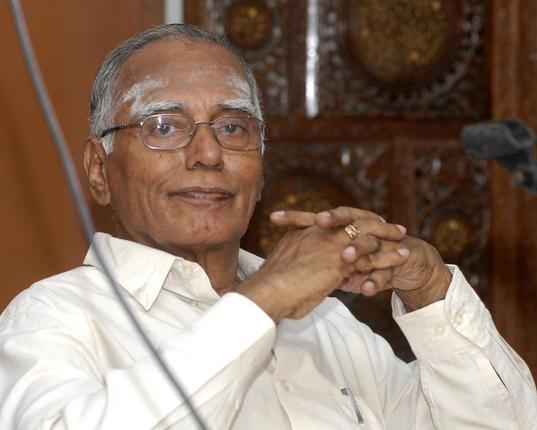The cultural
connection. Dr. R. Nagaswamy's 'Mirror of Tamil and Sanskrit'
-
Kausalya
Santhanam
Listen
to this article. Powered by Odiogo.com
July 5, 2012
The cultural connection
KAUSALYA SANTHANAM

Dr. R. Nagaswamy, Former Director, Dept. of Archaeology, Govt.
of Tamil Nadu. Photo: Archives
R. Nagaswamy’s latest book, ‘Mirror of Tamil and Sanskrit,’
shows the reciprocal relationship shared by Tamil-Sanskrit traditions.
“At no point was there an isolated development of Tamil
culture,” states R. Nagaswamy, former Director of Archaeology,
Government of Tamil Nadu. “At no point of time was any part
of the world isolated from its neighbourhood. The impact of the
North Indian tradition on various spheres in the Tamil region
cannot be denied. We are able to trace this tradition up to the
Vedas.”
Nagaswamy’s latest book, ‘Mirror of Tamil and Sanskrit,’
is an integrated study that shows the impact of Vedic tradition
and Sanskrit on Tamil life - its literature, art, music, dance,
legal system and social customs. In the book, he gives examples
from inscriptions, historical records, Tamil literature, social
life, civil administration, the judicial and legal fields.
The book is a chronological evaluation of the progress of Tamil
culture. The archaeologist talks to this correspondent on certain
aspects of his work. Excerpts:
Sanskrit and Vedic traditions; Brahmi
This book establishes for the first time that Tamil attained
classical status by adopting Vedic and Sanskrit traditions, especially
with the help of Brahmins in the formative stages. The Tamil script
is derived from Brahmi, which was invented by the Brahmins or
the Brahmanas when Emperor Asoka wanted to propagate his message
through his edicts. The earliest known written records in Tamil
are assigned to 2nd century BCE and are in the Brahmi script.
Asoka embraced Buddhism no doubt. But nowhere does he mention
that he is spreading Buddha Dharma. His edicts are about how a
civilised society should be - he is emphasising righteous conduct.
What the emperor says is not new; he is propagating the ancient
code ofconduct. “I want to enforce what kings have tried
to enforce earlier but have failed to do,” says Asoka. All
that he propagated was derived from the age-old teachings enshrined
in the Upanishads, especially Taittriya Upanishad. Also, Asoka
is not anti-Brahminical as is believed by some. Repeatedly he
emphasises in his edicts that Brahmins must be accorded respect.
Legal terminology
You find the legal terminology employed in Sanskrit legal texts
applied in early Sangam, Pallava, Chola and Pandya times. The
terminology found in the Dharma Sastras is employed in all these
administrative systems based on the general code of conduct formulated
during the Vedic period.
Tolkappiyam
The earliest Tamil grammar available today is Tolkappiyam. By
the time of Tolkappiyar and the Sangam poets, Tamil had been so
integrated with Prakrit and Sanskrit tradition that it is impossible
to isolate it from Sanskrit tradition. Tolkappiyar deals with
both Tamil and Sanskrit grammatical structures… he exhibits
it in many sutras in his work. The Sastraic tradition is reflected
in Agattinai.
Tolkappiyam shows that many of the concepts followed in Tamil
Nadu were found in the northern tradition, something that has
been denied in the past 50 years.
The Tamil poetics as prescribed in Tolkappiyam was adopted from
Sanskrit sources as for example phonetics and alankaras such as
Upama.
I’m looking at Tolkappiyam from two angles in the book.
The division of the land was into five groups. This is stated
by Bharata in his Natya Sastra when he talks of how the images
of these various divisions should be created on the stage so that
the audience experiences the feeling of being transported there.
The people of these five divisions in Tolkappiyam had their own
gods and they were all Vedic gods such as Indra, Varuna, Siva,
Vishnu, Kumara (Muruga)…
I have also dealt with the social aspect. There were the Brahmanas,
then the Kshatriyas, the Vanigars, and the Vellalars, the last
named were divided into two groups - all of them were eligible
for Moksha which is also mentioned in Sanskrit literature. If
you go deeper, the customs such as registration of marriage were
also introduced by Brahmins. The whole of Porul Adhikaram of Tolkappiyar
is based on Sanskrit literature.
Silappadikaram
Silappadikaram is only a Nadaga Kavya, not an epic as it is made
out to be. It is purely creative poetry for the purpose of dance.
“I’m using it to mirror society,” says the author
Ilango Adigal. Silappadikaram consists of three cantos. Each end-poem
describes what is contained in the canto. And that is based on
the particular virutti. This is the Sanskrit influence for it
is present in Natya Sastra.
The Vedic mode of worship was followed in the time of Silappadikaram.
Natya Sastra was the basis of aesthetics of music, dance and literature.
In turn, Tamil Kavyas were translated into Sanskrit - it was a
two-way or reciprocal relationship.
Sangam Literature
I have said that these poems are not folk poems but poetically
embellished works. They are not narrative poems and they are not
history. It is said that the old Sangam poets were relegated to
the background. But I have pointed out how century after century,
the rulers studied Sangam poets and how Brahmins have not suppressed
Tamil. There was no antagonism to Tamil anywhere and both Sanskrit
and Tamil have prospered.
There is no iron curtain - Tamil culture is part of the total
Indian culture. The whole of India was called “Navalar Theevu,”
the Tamil equivalent of Jambudvipa, and it was ruled by different
dynasties in different regions. But the outlook of the people
was the same and the culture was one.
Response to the book
The book has already generated a positive response from a few
scholars abroad. If scholars or others here want to refute anything
I have pointed out, they are welcome. But their arguments should
be based on facts and evidence and not on emotional response.
http://www.thehindu.com/arts/history-and-culture/article3606162.ece?homepage=true